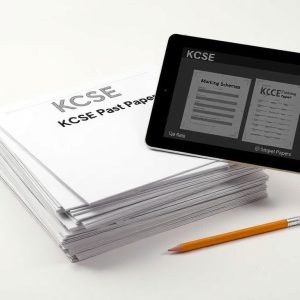Geography Paper 1: Form 4 QA Model – Document ID 20250302001
KSh 75.00 Original price was: KSh 75.00.KSh 50.00Current price is: KSh 50.00.
Featured Questions
Section A:
Answer all the questions in this section.
- The diagram below shows the structure of the earth.
- (a) Name the parts marked K and L. (2 marks)
- (b) Describe the composition of the mantle. (3 marks)
-
- (a) State two factors influencing atmospheric pressure on the earth’s surface. (2 marks)
- (b) Describe how a rain gauge is used to measure the amount of rainfall. (3 marks)
- The map below shows climate regions in Kenya. Use it to answer question (a) and (b).
- (a) Name the climatic regions Q and R. (2 marks)
- (b) Give three characteristics of the climate in the region marked R. (3 marks)
-
- (a) Distinguish between block disintegration and exfoliation. (2 marks)
- (b) State three economic benefits of the weathering process. (3 marks)
- The diagram below shows a waterfall.
- (a) Name the parts marked X, Y, and Z. (3 marks)
- (b) Give two ways in which a gorge may be formed. (2 marks)
Section B:
Answer question 6 and any other TWO questions from this section.
- Study the map of Kitale 1:50,000 (sheet 75/3) provided and answer the following questions.
- (a) (i) What is the six-figure grid reference of the trigonometrical station in Kitale DC? (2 marks)
- (ii) Give two districts found in the area covered by the map. (2 marks)
- (iii) Measure the distance of Suwerwa river in the South Western part of the area covered by the map. (Give your answer in kilometers.) (2 marks)
- (iv) Calculate the area of land covered by Kitale Municipality. (Give your answer in square kilometers.) (2 marks)
- (b) Using a vertical scale of 1cm represent 100 meters draw a cross-section along northing 28 from Easting 35 to Easting 41. (2 marks)
- (i) On the cross-section mark and name:
- Footpath (1 mark)
- River Saiwa (1 mark)
- Steep slope (1 mark)
- (ii) Calculate the vertical exaggeration (V.E) of the section. (2 marks)
- (c) Describe the relief of the area covered by the map. (4 marks)
- (d) Citing evidence from the map, give three reasons why cattle rearing is carried out in Kitale area. (6 marks)
-
- (a) (i) Differentiate between Orogenic and Epierogenic forces. (2 marks)
- (ii) Describe how isostatic adjustment causes earth movements. (4 marks)
- (b) The world map below shows major volcanoes. Use it to answer question (i)
- (i) Name the volcanoes marked U, V, and W. (3 marks)
- (ii) Give an example of a Lava plateau in Kenya. (1 mark)
- (c) Using a well-labeled diagram, describe how a batholith is formed. (7 marks)
- (d) Explain four significance of volcanicity to human activities. (8 marks)
-
- (a) What is a glacier? (2 marks)
- (b) Describe how the following glacial erosional processes occur.
- (i) Plucking (3 marks)
- (ii) Abrasion (3 marks)
- (c) The diagram below shows features on a glaciated lowland.
- (i) Name the features marked W, X, Y, and Z. (4 marks)
- (ii) Describe how a drumlin is formed. (5 marks)
- (d) Explain four negative effects of glaciations in low-land areas. (8 marks)
-
- (a) (i) State two characteristics of ocean water. (2 marks)
- (ii) State four factors which influence horizontal movement of ocean waters. (4 marks)
- (b) (i) Describe two ways through which continental Islands are formed. (4 marks)
- (ii) Name three features that form as a result of the emergence of coasts. (3 marks)
- (c) Explain three factors that influence wave deposition. (6 marks)
- (d) Using a labeled diagram describe how a tombolo is formed. (6 marks)
- (a) (i) Apart from rain and ice, name two other sources of underground water. (2 marks)
- (ii) Explain how the following factors influence the existence of groundwater.
- Nature of the rocks (2 marks)
- Vegetation cover (2 marks)
- (iii) Distinguish between phreatic and vadose zone. (2 marks)
- (b) The diagram below represents features in a limestone area.
- (i) Name the features marked X, Y, and Z. (3 marks)
- (ii) Describe how a limestone pillar was formed. (5 marks)
- (c) You are supposed to carry out a field study of an area eroded by underground water.
- (i) Name two erosional features you are likely to identify during the field study. (2 marks)
- (ii) State four reasons why you would prepare a work schedule. (4 marks)
- (iii) Give three follow-up activities you would engage in. (3 marks)
These questions cover a wide range of geographical topics, including physical geography, human geography, map skills, and practical applications of geographical knowledge.




Reviews
There are no reviews yet.